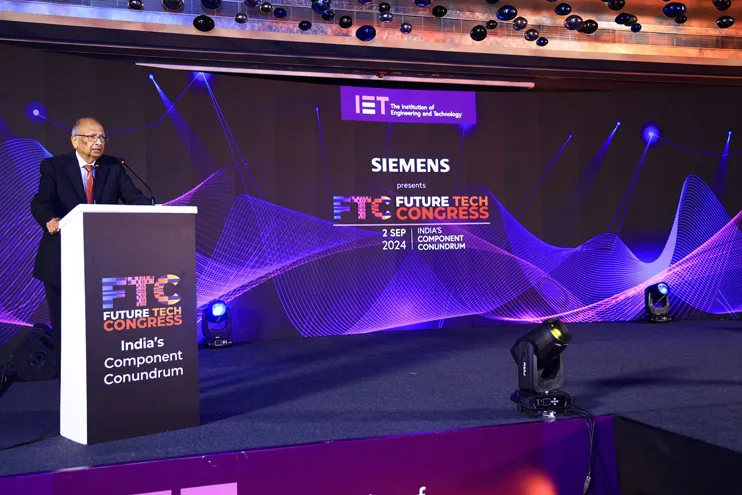Bringing India’s tech growth to the world stage
Chair of the IET’s India Future Tech Congress Dr Rishi Bhatnagar sits down with Member News to discuss how bringing together India’s key technologists could help solve the country’s ‘component conundrum’.

As Dr Rishi Bhatnagar explains, India has set itself a huge target for future economic growth. Informally known as the ‘digital transformation guy’, Rishi – who is also president of GlobeSecure and director of 11 other tech companies, co-author of the book Enterprise IoT and a serial tech investor – sees the annual IET Future Tech Congress as a forum for sharing ideas and meeting others.
“It’s where we sit together trying to review where we are. Whether we are from industry or academia, whether we are thought leaders, policymakers or start-ups, we are asking questions: What are the challenges of manufacturing components in India? What progress are we making? What kind of feedback can we give the government to achieve the overall goal?”
By the time we reach the centenary of Indian independence in 2047, the ambitious aim is that the country will satisfy the economic threshold for being a developed country. This involves growing the national economy to a 30-trillion-dollar platform. Today, the figure sits at around $4tn.
Self-reliant India
Prime Minister Narendra Modi has popularised the term Atmanirbhar Bharat – which translates to ‘self-reliant India’ – to lay out his government’s plans for the country to play a prominent role in the world economy.
While development of the component manufacturing and export sector will play a critical role in achieving Atmanirbhar Bharat, Rishi says that there are multiple additional parameters and metrics associated with the project, ranging from health and education to climate and employment, and so on. He discusses recent successes in lifting millions out of poverty and making massive strides in upgrading transport infrastructure, “but from a financial perspective we need to reach $30tn to be called a developed country”.
One pathway to India’s economic self-dependence is to increase the manufacturing base. Rishi explains how the government has announced its “intention to become a global manufacturing hub” and is exploring ways to make investing in India more attractive.
Incentives and policy changes
He adds that there have been many incentives and policy changes directed at overseas enterprises to promote inward investment, resulting in “India becoming one of the fastest-growing of the large economies” and giving industry in India confidence that it is on track.
A big message to come out of India’s 2047 vision is the encouragement of more electronic manufacturing into a country where there is an established template for industrial success. Rishi recalls how India once imported all of its cars, but “slowly we started to assemble them here.
Today we manufacture the components here, and all the global carmakers have manufacturing plants in India.” Growth in the mobile phone market followed a similar trajectory, and currently India is a net exporter of handsets. “But do we manufacture the displays, cameras, chipsets, speakers and microphones that go into them?” he asks. “No. We rely heavily on importing electronic components from Taiwan, China and Western countries. We want to avoid being dependent on key components that we can make for ourselves in India.”
Building in-country independence for a global powerhouse
Relying on imported components to create assembled products for export was a central concern at the recent IET Future Tech Congress in Bangaluru, where the theme and subtitle of the event was India’s component conundrum: Building in-country independence for a global powerhouse.
Bottlenecks and other hindrances in the supply chain were discussed, especially in the semiconductor manufacturing, mobility and healthcare sectors that together deliver a quarter of India’s GDP.
Within these applications, the technology focus of the conference emphasised three areas: the industrial metaverse, generative AI and quantum technology. Why these areas are so important at this point in India’s tech evolution, says Rishi, is that they are generating huge amounts of data, and wherever data is produced on a massive scale there is a slipstream demand for electronic componentry.
Build self-sufficiency on home territory
Rishi explains that one of the best solutions to the risks associated with overseas supply chains is to build self-sufficiency on home territory. This is vital for “ensuring technological sovereignty, economic resilience and long-term growth.” With past disruptions in global supply chains exposing India’s vulnerability to over-reliance on imported components, the way forward will concentrate on “developing domestic capabilities to ensure strategic autonomy and control over key technologies”.
But it’s not just about guaranteeing supply. Establishing a robust local supply chain for the electronics system design and manufacturing (ESDM) sector provides stimulus for economic growth, creates jobs and fosters innovation.
Rishi forecasts that by 2047 domestic manufacture of components for the electronics sector will go beyond simply fulfilling the country’s own requirements, “and we will become a net exporter, which will contribute a large sum towards that $30tn economy”.
Many innovations represent a “new terminology"
Rishi concedes that in India’s industrial space, many innovations at the Future Tech Congress represent a “new terminology”, with very few being aware that they exist. “An event like this is about creating that awareness and letting everyone know that there are people in the world working towards this type of computing.” He was excited to meet the CTO of a small start-up, a delegate, while flying back to Delhi. This CTO was delighted to have met a quantum expert in India and had discussed his products with five potential customers. Rishi says: “And that’s just one guy. I met so many in the same situation, all wanting to know where these technologies were taking them.”
Rishi attributes the success of the conference to people leaving their desks and meeting face to face. With the ambitious goal of getting the country to satisfy the economic threshold for being a developed country by 2047 lying ahead, he says: “If we carry on the way we’re going, we’ll hit the target.”
